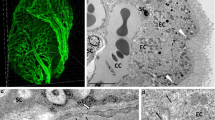Abstract
Using light and electron microscopy and immunocytochemistry methods, structural organization of the formed blood-cerebrospinal fluid barrier (BCSFB) of the human brain choroid plexus in embryos of 6–9 weeks of development was studied. The main structures peculiar to the mature BCSFB have been established to appear with formation of the choroid plexus at the end of the 2nd month of the human intrauterine development. Fenestrae in the choroid plexus capillary endothelium are revealed since the 9th week of prenatal development. Characteristic of the human embryonic BCSFB are a poor development of the plexus capillary basal membrane, scanty pericytes, a high activity of interstitial macrophages, which suggests the barrier immaturity. A significant amount of cytoplasmic glycogen inclusions revealed in plexus epitheliocytes seems to be due to peculiar trophic requirements of developing brain cells under conditions of an insufficient development of the local blood supply.
Similar content being viewed by others
REFERENCES
Kassil', G.N., Gemato-entsefalicheskii bar'er (Blood—Brain Barrier), Moscow, 1963.
Rosin, Ya.A., History and Theory of the Blood-Brain Barrier and Its Terminology, Fiziologiya gisto-gematicheskih bar'erov. Ser. “Rukovodstvo po fiziologii” (Physiology of Tissue-Blood Barriers. Series “Handbook of Physiology”), Moscow, 1977, pp. 119–126.
Przijalkowsky, W., Lipowski, D., Kolasa, T., et al., Bariera Krewplyn Mozgowo-Rdzeniowy y Ropnyh Zapaleniach Opon Mozgowo-Rdzeniowych i Mozgu, Neurol. Neurochir. Pol., 1996, vol. 30, pp. 39–48.
Tuomanen, E., Entry of Pathogen into the Central Nervous System, FEMS Microbiol. Rev., 1996, vol. 18, pp. 289–299.
Saunders, N.R., Habood, M.D., and Dziegielewska, K.M., Barrier Mechanisms in the Brain. I. Adult Brain, Clin. Exp. Pharmacol. Physiol., 1999, vol. 26, pp. 11–19.
Hampel, H., Kotter, H.U., and Moller, H.J., Blood-Cerebrospinal Fluid Barrier Dysfunction for High Molecular Weight Proteins in Alzheimer Disease and Major Depression: Indication for Disease Subsets, Alzheimer Disease Assoc. Disord., 1997, vol. 11, pp. 78–87.
Liebsch, R., Kornhuber, M.E., Dietl, D., et al., Blood-CSF Barrier Integrity in Multiple Sclerosis, Acta Neurol. Scand.,1996, vol. 94, pp. 404–410.
Qin, D., Ma, J., Xiao, J., and Tang, Z., Effect of Brain Irradiation on Blood-CSF Barrier Permeability of Chemotherapeutic Agents, Am. J. Clin. Oncol., 1997, vol. 20, pp. 263–265.
Bayard-Burfiels, L., Alling, C., Blennow, K., et al., Impairment of the Blood CSF Barrier in Suicide Attempters, Eur. Neuropsychopharmacol., 1996, vol. 6, pp. 195–199.
Sturrock, R.R., A Morphological Study of the Development of the Mouse Choroid Plexus, J. Anat., 1979, vol. 129, pp. 777–793.
Zaki, W., Ultrastructure of the Choroid Plexus and Its Development in the Mouse, Z. Mikrosk. Anat. Forsch., 1981, vol. 27, no. 6, pp. 1424–1429.
O'Rahilly, R., Bossy, J., and Muller, F., Introduction a l'Etude des Stades Embryonnaires chez l'Homme, Bull. Assoc. Anat., 1981, vol. 65, no. 189, pp. 141–236.
Dohrmann, G.J. and Bucy, P.C., Human Choroid Plexus: A Light and Electron Microscopic Study, J. Nurosurg., 1970, vol. 33, pp. 506–516.
O'Rahilly, R. and Muller, F., The Meninges in Human Development, J. Neuropathol. Exp. Neurol., 1986, vol. 45, pp. 588–608.
Osaka, K., Handa, H., Matsumoto, S., and Yasuda, M., Development of the Cerebrospinal Fluid Pathway in the Normal and Abnormal Human Embryos, Childs Brain, 1980, vol. 6, pp. 26–38.
Keep, R.F. and Jones, H.C., A Morphometric Study of the Development of the Lateral Ventricle Choroid Plexus, Choroid Plexus Capillaries and Ventricular Ependyma in the Rat, Dev. Brain Res., 1990, vol. 56, pp. 47–53.
Bauer, H.C., Bauer, H., and Lametschwandtner, A., Neovascularization and the Appearance of Morphological Characteristics of the Blood-Brain Barrier in the Embryonic Mouse Central Nervous System, Dev. Brain Res., 1993, vol. 75, pp. 269–278.
Yoshida, Y., Yamada, M., Wakabayashi, K., and Ikuta, F., Endothelial Fenestrae in the Rat Fetal Cerebrum, Dev. Brain Res., 1988, vol. 44, pp. 211–219.
Korzhevskii, D.E., Omel'chenko, N.V., Smirnov, E.B., and Petrova, E.S., Structure of Formed Blood Vessel of the Anlage of the Human Embryonic Neocortex, Morfologiya, 2000, vol. 117, no. 2, pp. 51–56.
Jucker, M., Tian, M., and Ingram, D.K., Laminins in the Adult and Aged Brain, Mol. Chem. Neuropathol., 1996, vol. 28, pp. 209–218.
Author information
Authors and Affiliations
Rights and permissions
About this article
Cite this article
Korzhevskii, D.E., Otellin, V.A. Morphological Ground of Formation of the Brain Choroid Plexus Blood-Cerebrospinal Fluid Barrier in Human Prenatal Ontogenesis. Journal of Evolutionary Biochemistry and Physiology 37, 200–204 (2001). https://doi.org/10.1023/A:1017697200837
Issue Date:
DOI: https://doi.org/10.1023/A:1017697200837




